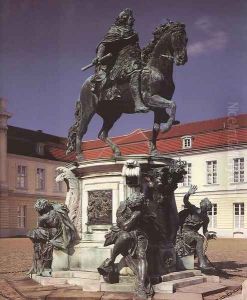Andreas Schluter Paintings
Andreas Schlüter was a prominent Baroque sculptor and architect who played a significant role in shaping the artistic landscape of Northern Europe during the late 17th and early 18th centuries. Born in 1664, possibly in Hamburg or Danzig (today's Gdańsk, Poland), Schlüter's early life is not well-documented, but it is believed that he began his artistic training in his youth.
Schlüter traveled extensively in his formative years, which was common for artists of his time. His travels took him through Germany, the Netherlands, and Italy, where he studied the works of the Italian masters, absorbing the influence of the Baroque style that was predominant in European art. This exposure to different cultural and artistic environments helped him develop a unique style that blended Northern European and Italian elements.
Upon his return to the German lands, Schlüter's career began to flourish. In 1694, he moved to Berlin at the invitation of Elector Frederick III of Brandenburg (later King Frederick I of Prussia), who was intent on transforming Berlin into a grand city that could rival the splendor of other European capitals. Schlüter was appointed as a court sculptor and architect, and he quickly became instrumental in the ambitious building projects that were underway.
One of his most renowned works is the Berlin Palace (Berliner Schloss), where he worked as the chief architect and contributed significantly to its design and decoration. Schlüter's sculptures often displayed a dynamic movement and emotional expressiveness characteristic of the Baroque style. His design for the equestrian statue of the Great Elector, Frederick William of Brandenburg, is considered a masterpiece and exemplifies his talent for capturing the grandeur and power of his subjects.
Apart from his work on the Berlin Palace, Schlüter was also responsible for the design and execution of various other significant projects, including the Arsenal (Zeughaus) in Berlin, which is now the German Historical Museum. His architectural and sculptural works are characterized by their dramatic forms, intricate details, and a sense of movement that brings the figures to life.
Despite his success, Schlüter's career faced difficulties in later years, including criticism of some of his projects and the physical strain of his work. He eventually left Berlin and spent his final years working in St. Petersburg, Russia, where he was invited by Tsar Peter the Great to contribute to the city's embellishment. However, his time in Russia was short-lived, and he passed away in 1714. Schlüter's legacy is evident in the numerous buildings and sculptures he left behind, which continue to be admired for their artistic excellence and historical significance.
